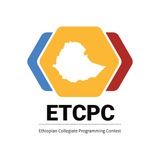|ETCPC
📢 Calling all graph enthusiasts! 📊🌐
📢 Join us for the thrilling continuation of our two-part tutorial on Graphs and Graph Algorithms - Part 2! 🎓
🗓️ Date: Mon, 14th August 2023
⏰ Time: 7:30 PM [1:30 Evening LT]
🎙️ Speaker: Mr. Abdi Adem, a seasoned programmer and graph algorithm expert.
🔥 Don't miss this incredible opportunity to deepen your understanding of graphs and explore essential graph algorithms like Shortest Path Algorithms and Minimum Spanning Trees! 🌟🔍
In Part 2 of this tutorial, we will unravel the fascinating world of shortest path algorithms. These algorithms are essential tools for finding the most efficient path between two vertices in a graph. We will cover:
1. Shortest Path Algorithms:
Shortest path algorithms are fundamental tools used to find the most efficient path between two vertices in a graph. They have numerous applications, ranging from navigation systems to network routing protocols. Here are two commonly used algorithms for finding the shortest path:
a) Dijkstra's Algorithm: Named after the Dutch computer scientist Edsger W. Dijkstra, this algorithm efficiently determines the shortest path in a graph with non-negative edge weights. By maintaining a priority queue, Dijkstra's algorithm explores vertices in increasing order of their distance from the source vertex.
b) Bellman-Ford Algorithm: This algorithm handles graphs with negative edge weights and detects negative cycles. It iteratively relaxes the edges of the graph until it finds the shortest path.
Next, we will dive into the concept of Minimum Spanning Trees (MSTs). An MST is a tree that spans all the vertices in a connected, weighted graph while minimizing the total sum of edge weights. We will explore:
2. Minimum Spanning Tree (MST) Algorithms:
Minimum spanning tree algorithms are used to find the most cost-effective way to connect all the vertices in a graph. The two main algorithms for finding MSTs are:
a) Kruskal's Algorithm: Named after the Czech mathematician Josef Kruskal, this algorithm builds an MST by iteratively adding the smallest-weighted edges that do not create cycles.
b) Prim's Algorithm: Named after the American mathematician Robert C. Prim, this algorithm grows an MST from an arbitrary starting vertex by greedily adding edges with the smallest weights.
We will dive into the intricacies of these algorithms, understand their time complexities, and discuss real-world applications.
Whether you're a novice seeking to expand your knowledge or an experienced enthusiast looking to refine your graph algorithm skills, this tutorial is perfect for you! Mr. Abdi Adem will present the concepts in a clear and engaging manner, making complex graph algorithms approachable for all attendees. 💪💡
Get ready to embark on a captivating journey as we explore the world of graphs and elevate your algorithmic thinking to new heights!
We eagerly anticipate your active participation in this enriching tutorial!
For any inquiries or further information, please contact us on Telegram @etcpc_support.
#ETCPC #GraphAlgorithms #GraphTheory #ShortestPathAlgorithms #MinimumSpanningTrees #KruskalsAlgorithm #PrimsAlgorithm #CodingTutorial #AlgorithmExpert #ProblemSolving #CodingEnthusiasts
📢 Calling all graph enthusiasts! 📊🌐
📢 Join us for the thrilling continuation of our two-part tutorial on Graphs and Graph Algorithms - Part 2! 🎓
🗓️ Date: Mon, 14th August 2023
⏰ Time: 7:30 PM [1:30 Evening LT]
🎙️ Speaker: Mr. Abdi Adem, a seasoned programmer and graph algorithm expert.
🔥 Don't miss this incredible opportunity to deepen your understanding of graphs and explore essential graph algorithms like Shortest Path Algorithms and Minimum Spanning Trees! 🌟🔍
In Part 2 of this tutorial, we will unravel the fascinating world of shortest path algorithms. These algorithms are essential tools for finding the most efficient path between two vertices in a graph. We will cover:
1. Shortest Path Algorithms:
Shortest path algorithms are fundamental tools used to find the most efficient path between two vertices in a graph. They have numerous applications, ranging from navigation systems to network routing protocols. Here are two commonly used algorithms for finding the shortest path:
a) Dijkstra's Algorithm: Named after the Dutch computer scientist Edsger W. Dijkstra, this algorithm efficiently determines the shortest path in a graph with non-negative edge weights. By maintaining a priority queue, Dijkstra's algorithm explores vertices in increasing order of their distance from the source vertex.
b) Bellman-Ford Algorithm: This algorithm handles graphs with negative edge weights and detects negative cycles. It iteratively relaxes the edges of the graph until it finds the shortest path.
Next, we will dive into the concept of Minimum Spanning Trees (MSTs). An MST is a tree that spans all the vertices in a connected, weighted graph while minimizing the total sum of edge weights. We will explore:
2. Minimum Spanning Tree (MST) Algorithms:
Minimum spanning tree algorithms are used to find the most cost-effective way to connect all the vertices in a graph. The two main algorithms for finding MSTs are:
a) Kruskal's Algorithm: Named after the Czech mathematician Josef Kruskal, this algorithm builds an MST by iteratively adding the smallest-weighted edges that do not create cycles.
b) Prim's Algorithm: Named after the American mathematician Robert C. Prim, this algorithm grows an MST from an arbitrary starting vertex by greedily adding edges with the smallest weights.
We will dive into the intricacies of these algorithms, understand their time complexities, and discuss real-world applications.
Whether you're a novice seeking to expand your knowledge or an experienced enthusiast looking to refine your graph algorithm skills, this tutorial is perfect for you! Mr. Abdi Adem will present the concepts in a clear and engaging manner, making complex graph algorithms approachable for all attendees. 💪💡
Get ready to embark on a captivating journey as we explore the world of graphs and elevate your algorithmic thinking to new heights!
We eagerly anticipate your active participation in this enriching tutorial!
For any inquiries or further information, please contact us on Telegram @etcpc_support.
#ETCPC #GraphAlgorithms #GraphTheory #ShortestPathAlgorithms #MinimumSpanningTrees #KruskalsAlgorithm #PrimsAlgorithm #CodingTutorial #AlgorithmExpert #ProblemSolving #CodingEnthusiasts
